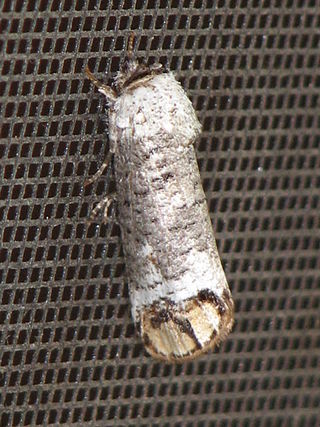
The Coleophoridae are a family of small moths, belonging to the huge superfamily Gelechioidea. Collectively known as case-bearers, casebearing moths or case moths, this family is represented on all continents, but the majority are found in temperate areas of the Northern Hemisphere. They are most common in the Palearctic, and rare in sub-Saharan Africa, South America, and Australia; consequently, they probably originated in northern Eurasia. They are relatively common in houses, they seek out moist areas to rest and procreate.

The Cossidae, the cossid millers or carpenter millers, make up a family of mostly large miller moths. This family contains over 110 genera with almost 700 known species, and many more species await description. Carpenter millers are nocturnal Lepidoptera found worldwide, except the Southeast Asian subfamily Ratardinae, which is mostly active during the day.

Urodidae, whose species are commonly known as false burnet moths, is a family of moths in the lepidopteran order. It is the type genus in the superfamily, Urodoidea, with three genera, one of which, Wockia, occurs in Europe.
Corycia is a synonym of several genera of Lepidoptera.
Koyaga is a genus of moths of the family Noctuidae. The genus was described by Ueda in 1984.

Isadelphina is a genus of moths of the family Erebidae. The genus was erected by George Hampson in 1926.
Dida cidaria is the only species in the monotypic moth genus Dida of the family Erebidae. It is known to be found in Mexico. Both the genus and the species were first described by Herbert Druce in 1891.
Eucalyptra is a monotypic moth genus of the family Heliodinidae. Its only species, Eucalyptra picractis, is known from Java. Both the genus and the species were first described by Edward Meyrick in 1921.

Goniophila is a genus of moths of the family Erebidae. The genus was erected by George Hampson in 1926.
Leucotelia is a monotypic moth genus of the family Erebidae erected by George Hampson in 1926. Its only species, Leucotelia ochreoplagata, was first described by George Hamilton Kenrick in 1917. It is found on Madagascar.
Orygmophora is a monotypic moth genus of the family Erebidae. Its only species, Orygmophora mediofoveata, is found in Ghana, Nigeria and Sierra Leone. Both the genus and species were first described by George Hampson in 1926.
Pseudotolna is a genus of moths of the family Erebidae. The genus was erected by George Hampson in 1926.

Tephriopis is a monotypic moth genus of the family Erebidae. Its only species, Tephriopis divulsa, was first described by Francis Walker in 1865.

Imaus is a genus of tussock moths in the family Erebidae. The genus was erected by Frederic Moore in 1879.
Dyscheralcis is a genus of moths in the family Geometridae. The genus was erected by Louis Beethoven Prout in 1916.
Acridotarsa is a genus of moths belonging to the family Tineidae. The genus was described by Edward Meyrick in 1893.
Pteropygme is a genus of moths of the family Heliodinidae. It contains only one species, Pteropygme pyrrha, which is found on the Bismarck Archipelago.
Capanica is a moth genus of in the family Heliodinidae.
Ethirastis is a genus of moths of the family Heliodinidae. It contains only one species, Ethirastis sideraula, which is found in Australia.
Haemangela is a genus of moths of the family Heliodinidae. It contains only one species, Haemangela vindicatrix, which is found on the Solomon Islands.







